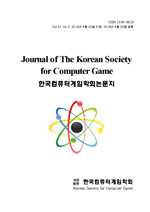학술논문
메타버스 트랩 극복위한 게이미피케이션 다이나믹 ‘습관형성’ 모델
이용수 37
- 영문명
- Gamification Dynamic Habit Building Model for Overcoming Metaverse Traps: Focusing on How to Build a Metaverse Space
- 발행기관
- 한국컴퓨터게임학회
- 저자명
- 김정태(Jung Tae KIM)
- 간행물 정보
- 『한국컴퓨터게임학회논문지』제37권 1호, 101~112쪽, 전체 12쪽
- 주제분류
- 공학 > 컴퓨터학
- 파일형태
- 발행일자
- 2024.03.30
4,240원
구매일시로부터 72시간 이내에 다운로드 가능합니다.
이 학술논문 정보는 (주)교보문고와 각 발행기관 사이에 저작물 이용 계약이 체결된 것으로, 교보문고를 통해 제공되고 있습니다.

국문 초록
이 논문은 직전 연구인 메타버스의 함정을 극복하기 위한 게임화된 동적 습관 형성 모델의 후속 연구다. 2022년 12월 논문 연구에서는 사용자 참여를 방해할 수 있는 일반적인 함정을 극복하기 위해 메타버스 공간을 설계하는 데 초점을 맞춘 게이미피케이션 동적 습관 형성 모델을 제안하였다. 당시 제안했던 4단계 접근법을 통합한 역학 모델은 낮은 상호작용(P4)의 온보딩 접근법, 기본 상호작용(P3) 온보딩 접근법, 중간 상호작용(P2)의 온보딩 접근법, 높은 상호작용(P1) 온보딩 접근법의 네 단계로 구성되었으며, 간단한 모델의 개요를 설명한 바 있다. 본고에서는 4단계의 세부 연구에 집중하였는데, P4-튜토리얼, 시즌 이벤트, 소셜 이벤트 및 모임, P3-기본 아바타, 가상경제 및 아이템 획득/거래, 소셜경쟁과 리더보드, 도전과 경쟁, 커뮤니티 강화, P2-아바타 개인화, 사용자 제작 콘텐츠. 보상 메커닉스 강화, 피드백 및 진행 상황추적, P1-대화형 튜토리얼, 사회적 상호작용, 내러티브 중심 퀘스트, 스토리 기반 업적, 인터렉티브 스토리 요소 등의 습관형성 증진 방안을 제시하였다. 각 단계는 게이미피케이션 및 게임디자인 기법과 사용자 중심 디자인 원칙을 통합하여 사용자의 참여를 유도하고, 습관 형성을 촉진하는 방향에서의 온보딩 접근법을 제시하고자 하였다. 이 논문에서는 게이미피케이션 및 게임디자인 이론과 실무를 바탕으로 각 단계에 대한 예시와 전략을 제공하여 메타버스에서 학습환경을 구현하는 데 도움을 줄 것이다. 다만, ‘게임’과 ‘메타버스’와의 개념과 용어에서의 명확한 구분이 어려운 상황이어서, 게이미피케이션 및 게임디자인 분야의 기초적인 이론과 온보딩 방법론을 다룰 수 밖에 없었다.
영문 초록
This paper is a follow-up to our previous work, A Gamified Dynamic Habit Formation Model to Overcome Metaverse Trap. In our December 2022 paper, we proposed a gamified dynamic habit formation model focused on designing metaverse spaces to overcome common pitfalls that can hinder user engagement. The dynamics model, which incorporated the four-stage approach we proposed at the time, consisted of four phases: a low-interaction (P4) onboarding approach, a basic interaction (P3) onboarding approach, a medium-interaction (P2) onboarding approach, and a high-interaction (P1) onboarding approach, and we outlined a simple model. In this article, we focus on a detailed study of the four phases: P4 - tutorials, seasonal events, social events and meetups; P3 - default avatar, virtual economy and item acquisition/trading, social competition and leaderboards, challenges and competitions, and community enrichment; P2 - avatar personalization and user-generated content. P1 - Enhanced reward mechanisms, feedback and progress tracking; P2 - Interactive tutorials, social interaction, narrative-driven quests, story-based achievements, and interactive story elements to promote habit formation. Each of these steps integrates gamification and game design techniques with user-centered design principles to present an onboarding approach that engages users and promotes habit formation. This paper will provide examples and strategies for each stage based on gamification and game design theory and practice to help you implement a learning environment in the Metaverse. However, due to the difficulty in making a clear distinction between the concepts and terminology of 'game' and 'metaverse', we had to cover basic theories and onboarding methodologies in the field of gamification and game design.
목차
1. Introduction
2. Previous research
3. Detailed study of a four-step approach to designing metaverse spaces
4. Conclusion
Acknowledgment
Reference
키워드
해당간행물 수록 논문
- 퍼즐 액션 게임 ‘MyEarth’의 구현 및 분석
- AI를 활용한 숏츠 애드버콘텐츠 이미지 생성에 관한 연구
- 엔드 게임 콘텐츠 디자인에 관한 고찰
- AHP를 활용한 게임 디자인 구성요소 모델 연구
- 퍼스 기호학을 통한 게임<원신>의 캐릭터 의상 디자인 특징 분석
- Media Facade 콘텐츠 제작 교육을 위한 Unity 3D Engine 기반 Projection Mapping Simulation
- 로그라이크 게임에서의 머신러닝 에이전트에 관한 연구
- 모바일 RPG 튜토리얼 구성요소 분석
- A method to incorporate Spherical Harmonic into URP for Real-Time Global Illumination in Unity Universal Render PipeLine
- Generative AI 도구와 플랫폼 디지털 아트 전공학생들에게 미치는 영향
- 실감 콘텐츠를 활용한 메타버스 플랫폼 전시공연 연구
- 메타버스 트랩 극복위한 게이미피케이션 다이나믹 ‘습관형성’ 모델
- 거리 측정의 일반화와 이를 이용한 Worley 노이즈 함수의 구현
- 미디어파사드의 이미지 재현 및 스토리텔링에 관한 연구
- 문화유산을 활용한 디지털콘텐츠 구현을 통한 보존과 계승
- 공간기반 콘텐츠를 기반한 확장현실 (XR) 콘텐츠 개발 연구
참고문헌
관련논문
공학 > 컴퓨터학분야 BEST
- 청소년들의 스마트폰 중독예방을 위한 이야기치료 집단상담 프로그램 개발
- 지도서비스를 이용한 위치 기반 관광 빅데이터의 시각화
- 광역 대중교통 접근성 향상이 관광 및 지역경제 활성화에 미치는 효과 분석
공학 > 컴퓨터학분야 NEW
- 스마트미디어저널 Vol13, No.11 목차
- YOLO 모델별 독성 해양 생물 탐지 성능 비교 및 스마트 수산 기술 적용 가능성 탐색
- 무인자동 양식어류 급이공급 시스템 개발 및 검증
최근 이용한 논문
교보eBook 첫 방문을 환영 합니다!

신규가입 혜택 지급이 완료 되었습니다.
바로 사용 가능한 교보e캐시 1,000원 (유효기간 7일)
지금 바로 교보eBook의 다양한 콘텐츠를 이용해 보세요!



